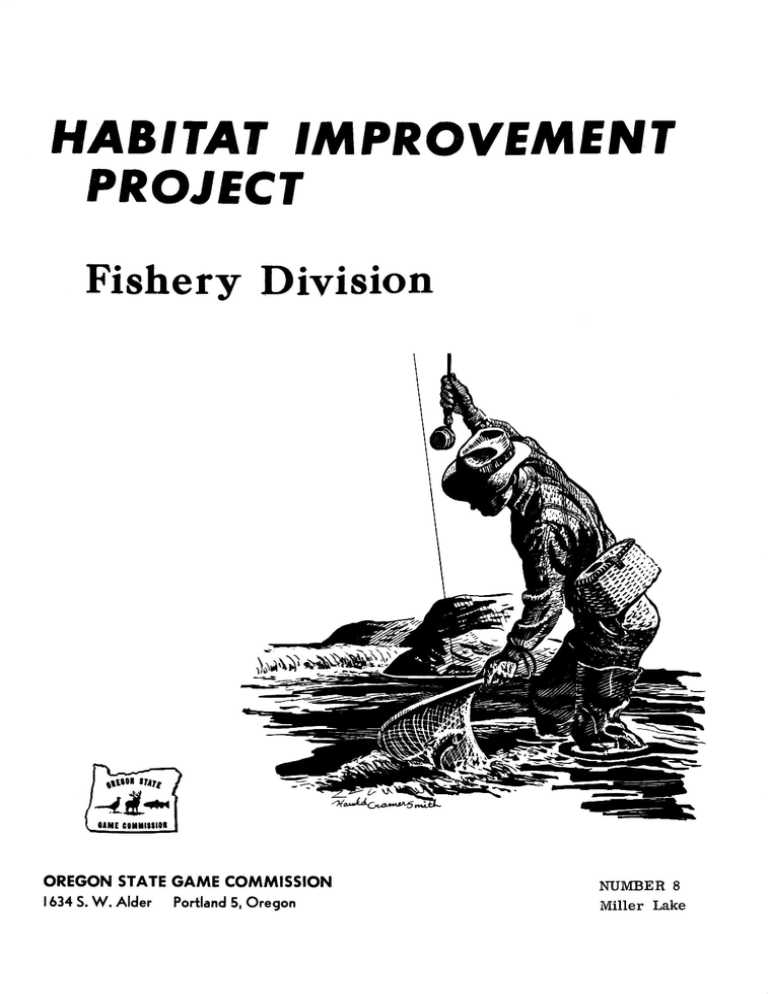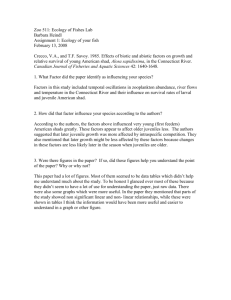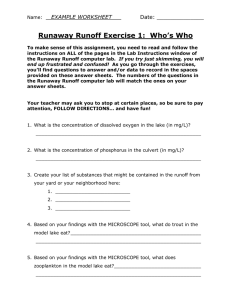HABITAT IMPROVEMENT Fishery Division PROJECT Miller Lake
advertisement

HABITAT IMPROVEMENT PROJECT Fishery Division 01,01 Mrs -411140004 SAME COMMISSION OREGON STATE GAME COMMISSION NUMBER 8 1634 S. W. Alder Miller Lake Portland 5, Oregon STATE OF OREGON OREGON STATE GAME COMMISSION P. W. Schneider, Director FEDERAL AID TO FISH RESTORATION FINAL REPORT State -wide Fishery Rehabilitation Miller Lake and Tributaries Segment F-20-D-11 By ,Arthur H. Gerlach Aquatic Biologist and Robert L,Borovicka Coordinating Biologist NUMBER 8 Miller Lake State Oregon Project No. F-20-D-11 Date DEC 1 1964 COMPLETION REPORT State-wide Fishery Rehabilitation Miller Lake and Tributaries Segment Period Covered: January 1, 1959 to March 1, 1964 ABSTRACT Miller Lake was chemically treated with toxaphene on September 16, 1958 to destroy a population of parasitic lamprey (E.tridentatus) and Tui Chub (Siphatelep bicolor). Toxaphene was applied at the rate of 0.04 ppm. No lamprey or fish have been collected in the lake since the chemical treatment. Work since 1959 has been in the form of testing the water for residual toxaphene and toxicity to trout. Materials and water were analyzed by Charlton Laboratories in Portland, Oregon by paper chromatography. The Agricultural Chemistry Department at Oregon State University conducted the majority of the analyses by gas chromatography. The detailed information on the chemical treatment was reported in a progress report February 13, 1959. Testing of Miller Lake willcontinue under Federal Aid Project No. F-20-D-20. Lamprey-.proof barrier A lamprey-proof barrierwasconstructed at the falls on Miller Creek approximately one-half mile downstream from the U. S., Forest Service bridge below the lake. The barrier was designed by the engineering staff of the Game Commission and constructed by crews from the Central Point screen plant. The dam is 36 feet long with a 12foot spillway. The structure is constructed of rock and mortar with a steel plate extending over the face of the dam to prevent lamprey from moving upeitream. streambed is approximately 44 inches. The height of the spillway from the The dam was constructed in August of 1959 and was still in good condition in 1964. It is possible that in 1965 some maintenance may be necessary to rein- force some of the mortar joints. Plate 1019 is a drawing of the structure. Testing for Toxicity The major activity other than the construction of the lamprey-proof barrier has been testing of the lake for toxicity to trout. The testing results will be presented by each year that the work was accomplished. 1958 - 1961 Tests for Toxicity The first test of rainbow trout to toxaphene was made simultaneously with the introduCtion of lamprey into seven different concentrations of toxaphene. The experiment was conducted in the concrete fry tanks inside the Klamath Hatchery building. Water was static as it was necessary to maintain a control on the toxaphene in the water. Rainbow were placed in water 12 days after the toxaphene was introduced in the concentrations 0.5 to 0.04 ppm. within 24 hours. All fish died In toxaphene concentrations from 0.05 to 0.001 ppm the large trout, approximately 8 inches long, died the first day while the fish of approximately 4 inches lived for three days. At the end of the three days all trout placed into the toxic water were dead. The water temperature was 54°F. No additional tests were made with trout before Miller Lake was chemically treated in September, 1958. The first testing of Miller Lake to determine the toxic level of the water was made in 1959. All trout died after 20 hours exposure. of the testing is shown in Table 1. The result The live-boxes used to hold trout in the lake in 1959 were constructed of metal rods and galvanized wire. It was first thought that there would be a toxic reaction from the galvanized wire used in the live-box. A test using one of the boxes containing two rainbow trout was made at the Klamath Hatchery. The two trout remained alive in the box for a period of one month. In 1960 live-boxes containing trout were placed into the lake in the same locations as in 1959. Two series of tests were conducted with the ad- dition of one new site in the last test. One of the boxes containing trout was placed into the outlet, Miller Creek, 'to determine if the water leaving the lake was toxic. The results of the two tests are presented in Table 1. 3 Table 1: Test Number Year 1959 1960 LI 1 foot List of a Series of Live-box Tests Made to Test Toxicity of Miller Lake From Introduction of Toxaphene in September, 1958 to August, 1961 Depth of live-box and time in hours to kill rainbow trout 3 10 feet 100 feet Outlet 50 feet 5 feet 30 feet 1 19 19 19 19 2 20 20 20 20 1 25 25 25 25 72 72 96(3 dead) 288(all dead) 96 2 1961 LZ 1 2 23 96(3 dead) 288(all dead) 96(4 dead) 288(all dead) 96(4 dead) 288(all dead) 1.1. /5 Stream 2 72 288 96 3 /4 Stream 1 288 264 All tests were conducted with live-boxes made of plastic screen and wood with exception of the stream tests. Z2 A control live-box was placed in Evening Creek for the tests made in 1960 and 1961; six trout were used in each live-box. .Z2 The site of the outlet test area is just below the lake on Miller Creek. LA The site of Stream 1 test area is approximately five miles upstream from Highway 97 on Miller Creek. The site of Stream 2 test area is at the Miller Creek Bridge approximately 7 miles from Highway 97. In August and November of 1960 Miller Lake water was analyZed at Charlton Laboratories in,Portland. The tests demonstrated that the amounts of toxaphene in the water were great enough tO kill trout. The results of the two tests are listed in Table 2. Results of AnalysOs of Miller Lake Water for Concentrations of Toxaphene Table 2: Year sample taken Concentrations of toxaphene in ppm 50-100 feet Surface Li 0.009 0.009 kOvember, 1960 0.014 0.008 July, 1961 Less than 0.001 Less than 0.001 August, 1961 Less than 0.001 Less than 0.001 AugUst, 1960 LI Both samples were combined in analyses. July, 1961, before live-box tests were initiated, a sample of Miller Lake water was analyzed for toxaphene. The results indicated that the toxic level had decreased to a concentration that would no longer be lethal to fish as determined by a search of literature. To test the indicated safe concen- trations, three live-boxes, constructed of plastic screen and wood were placed in different levels of the lake. trout. Each live-box contained rainbow After 96 hours exposure the fish in the deep area were all dead and those in the shallow area were dead or dying. dead. After 288 hours, all fish were A second test was made in August with the addition of a station on Miller Creek. The results were the same as the first test. A third test was made with fish in a live-box at the outlet of the lake. At the end of 286 hours the fish were all dead. It is possible that the live-boxes in the third test were distUrbed by visitors on the lake. 5 Trout in the control live-box in the tributary, Evening Creek, were never in distress through the entire experiment. Evening Creek was 44°F. The water temperature of Miller Creek water temperature was 46°F. on August 30, 1961. In the fall of 1961, 4,030 rainbow fingerlings, averaging 4 inches in length, were released into Miller Lake. Control fish were placed in live-boxes at the sites of previous tests to determine if trout released free in the lake would die at the same time interval as those in live-boxes. First observed mortalities occurred the second day of the experiment in a live-box in Miller Creek, at the outlet of the lake. fish were found dead in the live-box the next morning. Two additional In the evening of the same day, trout in distress were observed along the shallows in the vicinity of the forest camp on the south aide of the lake. The morning of the fourth day, a storm made the lake too rough to check for dying fish around the shore line. Fish in the live-box in Miller Creek near the outlet were dead and fish were dying in both live-boxes placed in the lake. The evening of the fourth day of the experiment, the lake became calm and five dead trout were observed in the shallows on the west end near the major tributary, Evening Creek. By the afternoon on the fifth day, many trout were observed dead or dying in the shallow areas at the west end of the lake. The remainder of the lake was too rough to check. The morning of the sixth day, the lake was calm and it was possible to check all the shallow areas. Dead rainbow trout were found in shoal areas of the lake and for 100 yards downstream in Miller Creek. fish out of six remained alive in each of live-boxes in the lake. One test The test using liberated trout indicated that the mortality of fish in live-boxes was similar to free-swimming fish. The experiment also indi- cated that there was sufficient toxaphene or some material present in the water to cause complete loss of any trout stocked in the fall of 1961. Water samples taken from Miller Lake in August 1961 were analyzed by the process of paper chromatography at Charlton Laboratories in Portland, Oregon. Toxaphene in concentrations of less than 0.001 ppm were found in the samples taken at 5 feet and 55 feet. 1962 - 1963 Tests for Toxicity The 1962-63 sampling procedures were changed at Miller Lake. Plants, aquatic organisms, bottom matter, and fish were included in the elements in and around the lake that were analyzed for the presence of toxaphene. Analysis of the samples collected was made by the Agricultural Chemistry Department at Oregon State University as a result of a contract with the Oregon State Game Commission. The technique used to determine the toxaphene residue was gas chromatography. Test fish were placed in Miller Lake to determine if the residues of toxaphene had declined to a safe level for trout. The longest period of trout survival to this time occurred in June, 1963, when fish lived for 17 days. Table 3 lists the results obtained from tests conducted in 1962 and 1963 and the amount of toxaphene present in the fish at the time of sacrifice or death. 7 Table 3: Results of Live-box Tests, Using Rainbow Trout - Miller Lake, 1962 - 1963 Length of time to kill all test fish Hours Days 168 7 Date test started July 7, 1962 L Toxaphene residue in test trout in ppm. 15.5 11 5 120 5.1 May 31, 1963 17 408 10.33 July 23, 1963 10 240 12.1 October 26, 1962 zi Fish were sacrificed for analysis To obtain a more accurate knowledge of the residue build-up in the trout, the second series of test fish was sacrificed at two-day intervals for a period of ten days. Fish that had been in the lake for two days contained 3.05 ppm of toxaphene. each sampling period. An increase of chemical was found after The final test fish died at the end of ten days, and the concentration of toxaphene had reached a peak of 12.1 ppm. No explana- tion can be given for the short period of survival of the fish in this test. Live-boxes containing test fish were placed at three different stations on Miller Creek in 1962 and 1963. The location of the test sites were: (1) Three miles upstream from Highway 97 (2) Miller Creek Bridge, six miles upstream from Highway 97 (3) Forest Service road crossing, 100 yards below Miller Lake. The 1962 test indicated that test fish near the lake died first and at approximately the same rate as those in the lake. Fish at the two lower sites lived longer with an elapsed time of 21 days before all fish were dead. In the 1963 test, the lower live-box was destroyed before the completion of the experiment. Of the original six trout placed in the live-box at Station 2 at the Miller Creek Bridge on May 31, 1963, one was still alive on Ally 3, thirtythree days later. The fish was sacrificed to determine the amount of toxaphene present in body tissues. The length of time required to kill all of the trout in the live-boxes and the concentration of toxaphene found in the trout are listed in Tables 4, 5 and 6. Table 4 Results of Live-box Tests, Using Rainbow Trout at Station 1, Miller Creek, 1962 - 1963. Number of days to kill all test fish Date test started July 5, 1962 16,9 21 /.1. October 26, 1962 5 La 17 May 31, 1963 Toxaphene residue in ppm 3.8 7.58 Fish sacrificed for analysis La Live-box damaged,but three dead trout remained of the original six fish. Table 5: Results of Live-box Tests, Using Rainbow Trout at Station 2, Miller Creek, 1962 - 1963 Date test started Number of days to kill all test fish July 5, 1962 October 26, 1962 21 6.89 5 3.00 La May 31, 1963 Toxaphene residue in ppm 13.00 33 L. Fish sacrificed for analysis Z2 One fish still alive and sacrificed for analysis 9 Table 6: Results of Live-bax_Testo, Using Rainbow Trout at Station 3, Miller Creek, 1962- 1963 Number of days to kill all test fish `Date test started Toxaphene Residue in ppm July 5, 1962 5 October 26, 1962 5 4.5 17 10.6 May 31, 1963 a. 11,2 A Fish sacrificed for analysis Plants were taken from the shore line and Submerged areas in Miller Lake and analyzed.for content of toxaphene. Table 7 lists the amount of toxaphene found in both plants and roots for the shore and submerged vegetation. In comparing.: the amount of residue present in the shore and submerged plants, it mas found that the quantity of toxaphene had gradually diminished in the plant portion of Eleocharis sp. and Polygonum sp. but had increased in the underground root system of Polygonum sp. In the two years that analyses have been made of Isoetaceae sp. (quillwort) there has been a gradual build-up of toxaphene residue from the start of the summer to the fall months. The algae, Nostoc ap., was analyzed in 1963 and did not vary much in the quantity of toxaphene residue present in the two samples. Table 7: Results of Analysis for Toxaphene in Vegetation, Miller Lake 1962 - 1963 Date Obtained and Toxaphene Residue in ppm 6/17/65 6/20/62 8/28/62 11/1/62 9'15'63 Shore Plants 12.8 ii_ Juncus sp. Roots of Juncus sp. 15.5 t__ Eleocharis sp. Roots of Eleocharis sp. 0.57 0.63 4.10 1.6 1.7 0.73 0.20 0.03 7.81 11.30 4.05 0.39 1.23 3.63 6.24 2.93 3.68 5.22 - - Submerged Plants .Iseotaceae sp.. - 0.86 2.49 9.00 Polygonum sp. Roots of Polygonum sp. - 1.44 3.10 5.40 (7/3/63) Algae Nostoc sp. L 4.47 4.68 Roots and plants combined Insect production is still limited at Miller Lake and the only specie available in sufficient numbers for an adequate sample was the dragonfly (Odonata sp.). Mayflies were observed in large numbers but a sample large enough to analyze could not be collected. No midges (Chironomus sp.) have been found in the bottom samples since the chemical treatment in 1958. numbers. and frogs. Leeches (Hirudinae sp.) have returned in large Table 8 presents data on toxaphene residues in insects, leeches Table 8: Results of Analysis for Toxaphene in Organisms, Miller Lake 1962 - 1963 Date Obtained and Toxaphene Residue in ppm Nov. 1 1962 June 17, 1963 Sept. 13, 1963 Species Odonata sp. 0.69 Hirudinae sp. - Rana sp. 3.55 Bufo sp. Less than 0.18 0.42 3.18 8.23 4.00 3.24 0.4 0.51 Future Testing The plan is to continue with detailed tests to determine the build-up of toxaphene residues in fish, aquatic organisms, vegetation and other materials. New tests for toxicity using live fish will be conducted. Another experimental stocking of trout will be made in the lake. Restocking Final restocking of the lake will not be attempted until tests prove the lake is not toxic to fish. Miscellaneous The segment is closed, but the Miller Lake work will continue under Project F-20-D-20. Financial Statement Project approval $ 10,523.00 Actual expenditures Ap ove James Feder 10,190.00 by: Submitted by: Coins Jr., A thur H. Gerla6h Aquatic Biologist Aid Funds Coordinator Charles J. Ctim bell R befrt L. Borovi a Coordinating Biologist Federal Aid(C6ordinator - 12 - rJ DOWNSTREAM FACE OF DAM SCALE RI-. l'O' A VICINTY MAP ve 0 I 2 MILES SECTION C e-o SCALE ASPHALT PLASTIC CEMENT A 6 t2 r-to" .1AFPLIED NOT LESS THAN r THICK 6" 7- B / 4eL PLAN AfAIE }11r. l/iXV'R.H. BOLTS re QC. Vet AC. FLOW . FLOW trixrese RUBBLE MASONRY DAM C L-BOLTS 24"± GC. BEDROCK 3 4.4 '045 12 of SECTION B-8 RUBBLE MASONRY DAM SCALE 1*- PROJECTION VIEW NOTE% WASH BEDROCK BY PUMP, MILLER LAKE TO EE CONSTRUCTED OF FIELDSTONE EMPLOYING GROUT, AFIZIOX. 19 CU.YD. STONE REQUIRED. 50 SACKS CEMENT REQUIRED. PROPOSED LAMPREY CONTROL DAM 6 CU.YD. SAM REQUIRED. BEDROCK SCALE SECTION A-4 AS SHOWN DRAWN 1143.56 BY Pa ENGINEER MGM NY AUT. 111111001 Oregon State Game Commission - Portland, Oregon APPIOVIII BY DIRICTOI 1019







